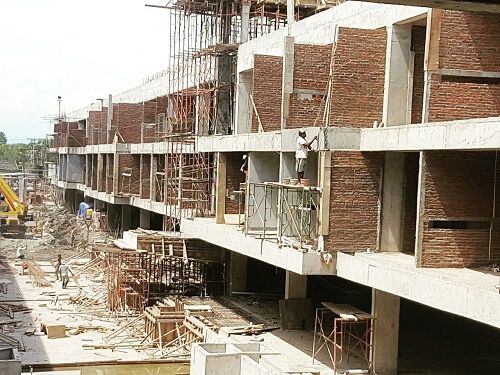The work of Constructing Buildings is one kind of art. Thus, there is a linear relationship between construction and building materials. Today’s modern housing associations, architectures, and engineers are concerned about ‘masonry walls’.
Masonry together with wood is considered one of the most important building materials in the History of humankind. It has been used as the construction material for several thousand years and still it is used. In the last decades, other materials like steel and concrete have been used frequently and thus replacing masonry as a structural material. This situation is present and particularly remarkable all over the countries, where almost all new buildings are constructed using reinforced concrete.
Masonry has been mostly used as a non-structural material, as an infill of reinforced concrete and steel frames. Therefore, a question must arise in our mind – what is it? How does it work or what to do with is this? Let us dig into this explanation:
The Masonry Basics
Masonry is a term used to indicate the part of the construction that uses brick, concrete blocks, structural clay tile, and stone. These materials are held together with mortar. Mortar for masonry is not cement mix, the material used for sidewalks, patios, or driveways. The mortar mix contains lime, sand, and gypsum, each in the proper proportions. Cement mix, on the other hand, has stones in the sand and does not contain lime.

What are Masonry Walls?
Masonry walls are the most durable part of any building or structure. Masonry is the word utilized for development with mortar as a coupling material with singular units of blocks, stones, marbles, rocks, solid squares, tiles, and so forth. Mortar is a blend of restricting material with sand. Restricting materials can be concrete, lime, soil, or any other constructing materials.
Professionals do the Masonry projects and the unit works for various purposes. Some works for building constructions, some makes barriers for boundaries to separate property line and some make house wall for structural used.
Types of Masonry Wall
Masonry walls render strengths, lastingness to the structure, and help to maintain indoor and outdoor temperature as well as keeps protect the buildings from the outside world. Depending on the motor mix materials, there are various types of Masonry Walls used in building constructions.
Types or Categories:
- Load-bearing masonry wall
- Reinforced masonry wall
- Hollow/Cavity masonry wall
- Composite masonry wall
- Post-tensioned masonry wall
Brief descriptions of these masonry wall types are given below.
1. Load-bearing Masonry Wall
Based on load-bearing walls could be Load Bearing and Non-load Bearing walls.
A load-bearing wall is a wall that bears a load reposing upon it, which depends on weight construction and the work of foundation structure. Usually, this type of wall is used for large buildings. e.g. housing or tall buildings construction work. It is mainly made with brick, concrete blocks, or stone. The load-bearing wall helps to transfer weight from the root to the foundation. This type of wall depends on the types of buildings and their number of stories that are assessed to a suitable thickness to bear the weight above them. Without this wall, there is a chance for instability in walls’ foundation works. Another, this type of wall can also be exterior and interior. Load-bearing walls are flexible because it is easy to spend a little amount of money than other types of walls, as it is the traditional framed structure of constructing buildings. The load-bearing walls can be reinforced or unreinforced masonry walls.
Non-load bearing walls that are only intended to support themselves and the weight of the cladding or sheathings attached. This kind of walls provides no structural support and maybe interior or exterior walls
2. Reinforced Masonry Wall
A reinforced masonry wall is made with any type of brick, concrete, or other types of masonry materials that strengthened the use of other building's materials to increase resistance to deterioration due to weight-bearing or other forms of stress. This type of wall could be non-load-bearing or load-bearing. One of the common examples of masonry involves exterior walls that are created using concrete blocks or clay bricks. Along with these materials, steel rods are works into the structure, often using some type of vertical framework that allows bearing the weight of connecting walls and floors within the building. The use of this type of wall helps it to resist pressure forces and heavy compression loads. During an earthquake or failure under heavy compression loads, the unreinforced walls could be crack horizontally. The purpose of this type of wall protects the walls from cracks and makes the strength to fight against unexpected earthquakes or other kinds of natural disasters. To defeat these problems, reinforced walls are used; and their quantity and spacing are based on walls and structure conditions. Reinforcement can be used both in horizontal and vertical order at a required layoff.
Depending on which materials are used, and how they are located, reinforced masonry (RM) walls can be divided into the following categories:
- Confined Masonry
- Reinforced Cavity Masonry
- Reinforced solid Masonry
- Reinforced hollow unit Masonry
- Reinforced grouted Masonry
- Reinforced pocket type Walls
3. Hollow/Cavity Masonry Wall
Hollow masonry walls are made with cement blocks. This type of masonry wall is used to stop dampness from getting inside the building. It creates a hollow area between the outside and inside of masonry walls. Cavity walls will also assist with climate control. Modern masonry walls are constructed from hollow masonry units or combined hollow and solid masonry units.
Solid walls are systematically certified by metal ties, masonry investments, or collective reinforcement.
4. Composite Masonry Walls
Composite Masonry walls are made with the combination of two or more building materials; stones and bricks or hollow bricks and bricks. The purpose of this type of wall construction is –reduce the overall cost of construction and make the structure durable by providing materials of better quality and good workmanship in the faces. Composite masonry walls work to improve the appearance of a structure by covering up the inferior works by the use of superior quality material in the desired positions. This type of wall is better because it is cost-effective and optically appealing.
Types of Composite Masonry walls:
- Brick Backed Ashlar
- Brick facing with Rubble or Concrete Backing
- Stone facing with Brick, Rubble, or concrete Backing
5. Post-tensioned Masonry Wall
Post-tensioning provides an additional axial load to masonry structures and thus increases resistance to lateral force. This type of wall has over their conventionally reinforced equivalents, such as increased in-plane strength and the absence of residual post-earthquake wall displacements. Post-tensioning now is used extensively in bridges, elevated slabs (parking structures and residential or commercial buildings), residential foundations, walls, and columns. Designers commonly take advantage of this method to produce buildings and structures with clear open spaces allowing more architectural freedom.

